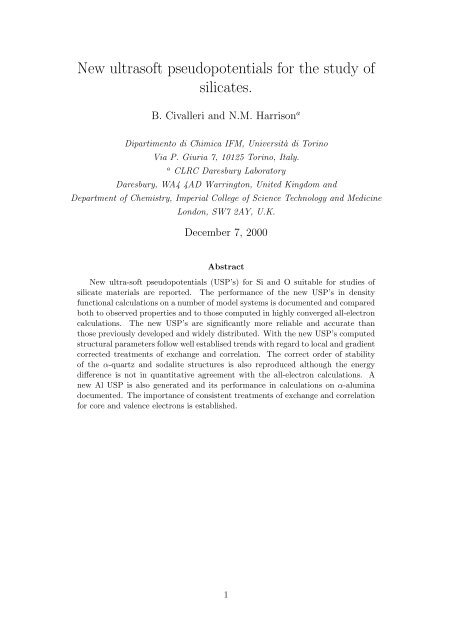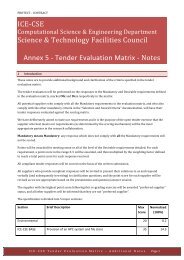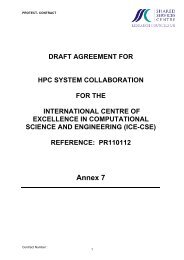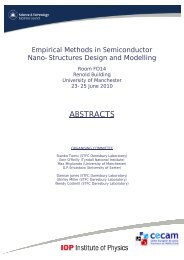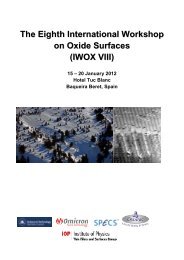New ultrasoft pseudopotentials for the study of silicates. - STFC's ...
New ultrasoft pseudopotentials for the study of silicates. - STFC's ...
New ultrasoft pseudopotentials for the study of silicates. - STFC's ...
Create successful ePaper yourself
Turn your PDF publications into a flip-book with our unique Google optimized e-Paper software.
and p bound state eigenvalues. A new potential has been generated utilising <strong>the</strong> sameneutral 2s 2 2p 4 electronic configuration but with s- and p-channels treated as non-localcomponents with reference energies set to <strong>the</strong> appropriate bound state eigenvalue and<strong>the</strong> eigenvalue plus 0.5 Ry. We used a core cut<strong>of</strong>f radius <strong>of</strong> 1.3 a.u. <strong>for</strong> both s and pvalence wave functions and 1.0 a.u. <strong>for</strong> <strong>the</strong> local potential. The L dependent r inner radiiused <strong>for</strong> pseudizing <strong>the</strong> localized core-region charge augmentation function Q ij (r) werechosen to be 0.7 a.u. <strong>for</strong> all angular momenta.It is worth noting that despite what we believe to be a significantly better method <strong>of</strong> construction<strong>the</strong> new O-USP generated here, when used in conjunction with <strong>the</strong> CASTEP-MSI Si-USP, gives similar results to those reported above using <strong>the</strong> original O-USP. Thisconfirms that <strong>the</strong> discrepancies documented above are mainly due to faults in <strong>the</strong> Si-USP.4.3 Testing <strong>the</strong> new Si and O <strong>pseudopotentials</strong>The structure and energetics <strong>of</strong> α-quartz and sodalite computed using <strong>the</strong> new <strong>pseudopotentials</strong>are summarissed in Tables 7, 8 and 9.In comparing <strong>the</strong> present results with both <strong>the</strong> literature and <strong>the</strong> previous ones, <strong>the</strong>reis an important aspect to take into account. The <strong>pseudopotentials</strong> <strong>of</strong> <strong>the</strong> CASTEP-MSIlibrary are constructed from <strong>the</strong> AE-LDA atomic solution. It has become a common practiceto use such LDA-<strong>pseudopotentials</strong> even when treating <strong>the</strong> valence electrons within<strong>the</strong> GGA approximation. This is a possible source <strong>of</strong> errors in <strong>the</strong> PW-GGA calculationsreported above. Indeed, <strong>the</strong> new Si-USP based on an AE-LDA atomic solution,gives excellent results at LDA level, but results <strong>for</strong> a GGA valence treatment are stillpoor. Adopting GGA <strong>pseudopotentials</strong> based on fully self-consistent GGA all-electronatomic calculations give results in much better agreement with <strong>the</strong> AE-GGA calculationsas shown in Table 7. This correction results in a leng<strong>the</strong>ning <strong>of</strong> <strong>the</strong> Si-O bond and adecrease <strong>of</strong> <strong>the</strong> Si-O-Si angle can be observed, even if <strong>the</strong> Si-O-Si angle is still very large.The GGA Si-O bonds are now longer than LDA ones showing <strong>the</strong> same trend observed<strong>for</strong> AE calculations. Never<strong>the</strong>less, in <strong>the</strong> GGA case, <strong>the</strong> combination <strong>of</strong> longer Si-Obonds and larger Si-O-Si angles yields bigger cells. These results are in agreement withdata published recently by Hafner and co-workers using <strong>the</strong> VASP s<strong>of</strong>tware [19] whichare displayed in Table 1. The remaining differences between <strong>the</strong> two sets <strong>of</strong> data arelikely to be due to <strong>the</strong> different electronic configuration adopted as reference states in<strong>the</strong> AE atomic calculations, as in ref. [19] a neutral reference configuration was adopted<strong>for</strong> <strong>the</strong> Si-USP.In Table 8 <strong>the</strong> sensitivity <strong>of</strong> <strong>the</strong> calculations to details <strong>of</strong> <strong>the</strong> pseudopotential constructionare documented. Potentials within <strong>the</strong> GGA are used in which ei<strong>the</strong>r two projectorsin <strong>the</strong> p channel are used (CH1) or <strong>the</strong> local potential is chosen so that <strong>the</strong> logarithmicderivative is correct at <strong>the</strong> second valence eigenvalue (CH2). Notice that in both cases<strong>the</strong> LDA atomic solution was adopted <strong>for</strong> creating <strong>the</strong> USPs. Adding two projectors in<strong>the</strong> p channel (CH1) does not yield any improvement while CH2 tends to yield shorterSi-O bonds and larger Si-O-Si angle which is reminiscent <strong>of</strong> <strong>the</strong> data generated from <strong>the</strong>CASTEP-MSI <strong>pseudopotentials</strong>.In table 6 it was shown that <strong>for</strong> crystalline microporous siliceous materials <strong>the</strong> CASTEP-MSI USP’s do not give <strong>the</strong> right order <strong>of</strong> stability with respect to α-quartz. The relativestability with respect to sodalite, only, is documented in Table 9. The new USP’s produce<strong>the</strong> correct order <strong>of</strong> stability although <strong>the</strong> energy difference between α-quartz andsodalite is significantly less than that computed in AE-GTF calculations(see Table 6).6
4.4 Aluminum pseudopotentialAs we are interested in <strong>study</strong>ing aluminosilicate systems, such as zeolites, we examined<strong>the</strong> per<strong>for</strong>mance <strong>of</strong> <strong>the</strong> Al-USP distributed in <strong>the</strong> CASTEP-MSI library. This potentialwas constructed in a similar way to <strong>the</strong> Si-USP with a core radius <strong>of</strong> 2.0 a.u.. In zeolites<strong>the</strong> average Al-O distance is around 3.34 a.u., which is very close to <strong>the</strong> sum <strong>of</strong> <strong>the</strong> cut<strong>of</strong>fradii <strong>of</strong> <strong>the</strong> Al and O USPs leading to almost overlapping core regions under ambientconditions. There<strong>for</strong>e, in order to increase <strong>the</strong> reliability <strong>of</strong> <strong>the</strong> potentials, <strong>the</strong> Al r c wasreduced to 1.7 a.u.. The new USP was constructed using essentially <strong>the</strong> same conditionsadopted <strong>for</strong> silicon (see above). The neutral 3s 2 3p 1 reference configuration was used withnonlocal projectors in s and p channels and a single reference energy <strong>for</strong> each channeltaken to be <strong>the</strong> atomic eigenvalue. The cut<strong>of</strong>f radius <strong>for</strong> both s and p valence functionsand <strong>for</strong> <strong>the</strong> local potential were taken to be 1.7 and 1.3 a.u., respectively. The cut<strong>of</strong>fr inner was chosen to be 1.1 <strong>for</strong> all angular momenta. As <strong>for</strong> <strong>the</strong> Si and O potentials, twoversions <strong>of</strong> <strong>the</strong> new Al-USP were generated based on LDA and GGA all-electron atomicsolutions.As a test case α-alumina was adopted. In Table 10 PW-GGA results are reported incomparison with a few available data. The new Al-USP gives results in good agreementwith experimental and with <strong>the</strong> AE calculations. The new USP generated from a AE-GGA atomic solution follows <strong>the</strong> same trend observed in <strong>the</strong> <strong>silicates</strong> - <strong>the</strong> unit cellvolume is larger, and <strong>the</strong> Al-O bonds longer than predicted by <strong>the</strong> LDA. This trend isin agreement with <strong>the</strong> AE results.4.5 O<strong>the</strong>r <strong>pseudopotentials</strong> - H, C, NAs <strong>the</strong> need to base GGA calculations on potentials generated from GGA atomic solutionsis very clear a number <strong>of</strong> o<strong>the</strong>r psedopotentials were regenerated from <strong>the</strong> fully selfconsistentGGA all-electron atom calculations but using computational conditions essentially<strong>the</strong> same as those existing in <strong>the</strong> CASTEP-MSI library. <strong>New</strong> H, C, N were generatedin this way and are documented in <strong>the</strong> Appendix. The H-USP was generated with parameterssuggested by C. Pickard (see http://www.cse.clrc.ac.uk/S<strong>of</strong>tware/CASTEP/H 00.usp).5 Conclusions<strong>New</strong> ultra-s<strong>of</strong>t <strong>pseudopotentials</strong> (USP’s) <strong>for</strong> Si and O suitable <strong>for</strong> studies <strong>of</strong> silicate materialshave been generated. The per<strong>for</strong>mance <strong>of</strong> <strong>the</strong> new USP’s in density functionalcalculations on a number <strong>of</strong> model systems has been documented. A detailed comparisonto experimentally observed structures and previous <strong>the</strong>oretical calculations <strong>of</strong> structuresand energetics has been made. Highly converged all-electron calculations have been usedas a benchmark <strong>for</strong> <strong>the</strong> quality <strong>of</strong> <strong>the</strong> USP’s. The new USP’s are significantly morereliable and accurate than those previously developed and widely distributed. With <strong>the</strong>new USP’s computed structural parameters follow well established trends with regard tolocal and gradient corrected treatments <strong>of</strong> exchange and correlation. The correct order <strong>of</strong>stability <strong>of</strong> <strong>the</strong> α-quartz and sodalite structures is also reproduced although <strong>the</strong> energydifference is not in quantitative agreement with <strong>the</strong> all-electron calculations. A new AlUSP is also generated and its per<strong>for</strong>mance in calculations on α-alumina documented.The importance <strong>of</strong> consistent treatments <strong>of</strong> exchange and correlation <strong>for</strong> core and valenceelectrons is established and new H, C and N <strong>pseudopotentials</strong> suitable <strong>for</strong> GGAcalculations are reported.7
All <strong>of</strong> <strong>the</strong> settings used in creating <strong>the</strong> new USP’s reported here are given in Appendix1. The new USP’s, in a <strong>for</strong>mat suitable <strong>for</strong> CASTEP calculations, may be obtainedby sending email to ukcp@dl.ac.uk..6 AcknowledgmentsThe authors are grateful D. Vanderbilt <strong>for</strong> permission to use his pseudopotential generations<strong>of</strong>tware, details <strong>of</strong> his work on generating Si-USP’s and helpful discussions. Theauthors also thank P.J.D. Lindan, C.J. Pickard, M.C. Payne, D. King-Smith and J.D.Gale <strong>for</strong> suggestions and helpful discussions. All calculations were perfomed on <strong>the</strong>Cray-T3E machine at <strong>the</strong> CSAR service in Manchester and were supported by <strong>the</strong> EP-SRC’s High Per<strong>for</strong>mance Computing Initiative within <strong>the</strong> U.K. Car-Parrinello consortium(GR/N02337).References[1] D. Vanderbilt, Phys. Rev. B 41 (1990) 7892[2] CASTEP 3.9 academic version, licensed under <strong>the</strong> UKCP-MSI agreement, 1999[3] L. Kleinman, D.M. Bylander, Phys. Rev. Lett. 48 (1992) 1425[4] P. J. D. Lindan, The Guide to CASTEP 3.9, Daresbury Laboratory, CLRC, 1999.(see http://www.cse.dl.ac.uk/Activity/UKCP <strong>for</strong> fur<strong>the</strong>r details)[5] G.P. Francis, M.C. Payne, J. Phys. Condens. Matter 17 (1990) 1643[6] V. R. Saunders, R. Dovesi, C. Roetti, M. Causà, N. M. Harrison, R. Orlando andC. M. Zicovich-Wilson, CRYSTAL-98 User’s Manual (Università di Torino, Torino,1999).[7] B. Civalleri, C.M. Zicovich-Wilson, P. Ugliengo, V.R. Saunders, R. Dovesi, Chem.Phys. Lett. 292 (1998) 394.[8] B. Civalleri, S. Casassa, E. Garrone, C. Pisani, P. Ugliengo, J. Phys. Chem. B 103(1999) 2165.[9] P. Ugliengo, B. Civalleri, R. Dovesi, C. M. Zicovich-Wilson, Phys. Chem. Chem.Phys. 1 (1999) 545.[10] P. Ugliengo, B. Civalleri, C. M. Zicovich-Wilson, R. Dovesi, Chem. Phys. Lett. 318(2000) 247.[11] G.A. Lager, J.D. Jorgensen, F.J. Rotella, J. Appl. Phys. 53 (1982) 6751[12] D.C. Allan, M.P. Teter, Phys. Rev. Lett. 59 (1987) 1136; J. Am. Ceram. Soc. 73(1990) 3274[13] J.R. Chelikowsky, H.E. King, Jr., N. Trouiller, J.L. Martins, J. Glinnermann, Phys.Rev. Lett. 65 (1990) 3309[14] F. Liu, S.H. Gar<strong>of</strong>alini, D. King-Smith, D. Vanderbilt, Phys. Rev. B 49 (1994) 125288
[15] D.M. Teter, G.V. Gibbs, M.B. Boisen, Jr., D.C. Allan, M.P. Teter, Phys. Rev. B 52(1995) 8064[16] G.V. Gibbs, K.M. Rosso, D.M. Teter, M.B. Boisen, Jr., M.S.T. Bukowinski, J. Mol.Struct. 485-486 (1999) 13[17] B. Holm, R. Ahuja, J. Chem. Phys. 111 (1999) 2074[18] D.R. Hamann, Phys. Rev. Lett. 76 (1996) 660[19] Th. Demuth, Y. Jeanvoine, J. Hafner, J.G.(1999) 3833Ángyán, J. Phys. Condens. Matter 11[20] FLAPW (WIEN97); LDA=PW, GGA=PBE; A. Zupan, P. Blaha, K. Schwarz, J.P.Perdew, Phys. Rev. B 58 (1997) 11266[21] M. Catti, B. Civalleri, P. Ugliengo, J. Phys. Chem. B 104 (2000) 7259[22] I. Petrovic, P.J. Heaney, A. Navrotsky, Phys. Chem. Minerals 23 (1996) 119[23] I. Petrovic, A. Navrotsky, M.E. Davis, S.I. Zones, Chem. Mater. 5 (1993) 1805[24] W.E. Lee, K.P.D. Lagerl<strong>of</strong>, J. Electron Microscop. Technol. 2 (1985) 247[25] Y. Yourdshahyan, C. Ruberto, L. Bengston, B.I. Lundqvist, Phys. Rev. B 56 (1997)8553[26] I. Manassidis, M.J. Gillan, J. Am. Ceram. Soc. 77 (1994) 335[27] A. Wander; CRYSTAL: HF and HF+DFT a posteriori correction, basis set=Al[85-11G(d)],O[8-411G(d)]; unpublished results9
Appendix: Details <strong>of</strong> <strong>the</strong> new USP’sSi 01 V.usp<strong>New</strong> USP generated by B. Civalleri (N.M. Harrison)============================================================| pseudopotential report: version 7.3.2 date 10-26-1999 |------------------------------------------------------------| silicon ceperley-alder exchange-corr || z = 14. zv = 4. exfact = 0.00000 || etot = -6.93915 || index orbital occupation energy || 1 300 2.00 -1.40 || 2 310 1.00 -0.86 || keyps = 3 ifpcor = 0 || rinner = 0.80 <strong>for</strong> L= 1 || rinner = 0.80 <strong>for</strong> L= 2 || rinner = 0.80 <strong>for</strong> L= 3 || new generation scheme: || nbeta = 2 kkbeta = 545 rcloc = 1.0000 || ibeta l epsilon rcut || 1 0 -1.40 1.40 || 2 1 -0.86 1.40 || lloc =-1 eloc = 0.000 || ifqopt = 2 nqf = 8 qtryc = 10.000 || all electron calculation used koelling-harmon equation || ************logarithmic mesh************ |============================================================Si 01 Vgga.usp<strong>New</strong> USP generated by B. Civalleri (N.M. Harrison) The AE-GGA(PW91) solution wasused.============================================================| pseudopotential report: version 7.3.2 date 10-26-1999 |------------------------------------------------------------| silicon slater x-alpha exchange-corr || z = 14. zv = 4. exfact = 4.00000 || etot = -6.93013 || index orbital occupation energy || 1 300 2.00 -1.40 || 2 310 1.00 -0.86 || keyps = 3 ifpcor = 0 || rinner = 0.80 <strong>for</strong> L= 1 || rinner = 0.80 <strong>for</strong> L= 2 || rinner = 0.80 <strong>for</strong> L= 3 || new generation scheme: || nbeta = 2 kkbeta = 545 rcloc = 1.0000 || ibeta l epsilon rcut || 1 0 -1.40 1.40 || 2 1 -0.86 1.40 || lloc =-1 eloc = 0.000 || ifqopt = 3 nqf = 8 qtryc = 10.000 || all electron calculation used koelling-harmon equation || ************logarithmic mesh************ |============================================================10
Al 01 CB.uspUSP generated by B. Civalleri (N.M. Harrison).============================================================| pseudopotential report: version 7.3.2 date 10-27-1999 |------------------------------------------------------------| aluminum ceperley-alder exchange-corr || z = 13. zv = 3. exfact = 0.00000 || etot = -3.89524 || index orbital occupation energy || 1 300 2.00 -0.58 || 2 310 1.00 -0.20 || keyps = 3 ifpcor = 0 || rinner = 1.10 <strong>for</strong> L= 1 || rinner = 1.10 <strong>for</strong> L= 2 || rinner = 1.10 <strong>for</strong> L= 3 || new generation scheme: || nbeta = 2 kkbeta = 557 rcloc = 1.3000 || ibeta l epsilon rcut || 1 0 -0.58 1.70 || 2 1 -0.20 1.70 || lloc =-1 eloc = 0.000 || ifqopt = 3 nqf = 8 qtryc = 10.000 || all electron calculation used koelling-harmon equation || ************logarithmic mesh************ |============================================================Al 01 CBgga.uspUSP generated by B. Civalleri (N.M. Harrison). The AE-GGA(PW91) solution was used.============================================================| pseudopotential report: version 7.3.2 date 10-27-1999 |------------------------------------------------------------| aluminum slater x-alpha exchange-corr || z = 13. zv = 3. exfact = 4.00000 || etot = -3.88039 || index orbital occupation energy || 1 300 2.00 -0.57 || 2 310 1.00 -0.20 || keyps = 3 ifpcor = 0 || rinner = 1.10 <strong>for</strong> L= 1 || rinner = 1.10 <strong>for</strong> L= 2 || rinner = 1.10 <strong>for</strong> L= 3 || new generation scheme: || nbeta = 2 kkbeta = 557 rcloc = 1.3000 || ibeta l epsilon rcut || 1 0 -0.57 1.70 || 2 1 -0.20 1.70 || lloc =-1 eloc = 0.000 || ifqopt = 3 nqf = 8 qtryc = 10.000 || all electron calculation used koelling-harmon equation || ************logarithmic mesh************ |============================================================11
O 01 CB.uspCreated by B. Civalleri (N.M. Harrison)============================================================| pseudopotential report: version 7.3.2 date 10-21-1999 |------------------------------------------------------------| oxygen ceperley-alder exchange-corr || z = 8. zv = 6. exfact = 0.00000 || etot = -31.52093 || index orbital occupation energy || 1 200 2.00 -1.74 || 2 210 4.00 -0.68 || keyps = 3 ifpcor = 0 || rinner = 0.70 <strong>for</strong> L= 1 || rinner = 0.70 <strong>for</strong> L= 2 || rinner = 0.70 <strong>for</strong> L= 3 || new generation scheme: || nbeta = 4 kkbeta = 519 rcloc = 1.0000 || ibeta l epsilon rcut || 1 0 -1.74 1.30 || 2 0 0.50 1.30 || 3 1 -0.68 1.30 || 4 1 0.50 1.30 || lloc = 2 eloc = 0.000 || ifqopt = 2 nqf = 8 qtryc = 10.000 || all electron calculation used schroedinger equation || ************logarithmic mesh************ |============================================================O 01 CBgga.uspCreated by B. Civalleri (N.M. Harrison) The AE-GGA(PW91) solution was used.============================================================| pseudopotential report: version 7.3.2 date 10-26-1999 |------------------------------------------------------------| oxygen slater x-alpha exchange-corr || z = 8. zv = 6. exfact = 4.00000 || etot = -31.63430 || index orbital occupation energy || 1 200 2.00 -1.76 || 2 210 4.00 -0.67 || keyps = 3 ifpcor = 0 || rinner = 0.70 <strong>for</strong> L= 1 || rinner = 0.70 <strong>for</strong> L= 2 || rinner = 0.70 <strong>for</strong> L= 3 || new generation scheme: || nbeta = 4 kkbeta = 519 rcloc = 1.0000 || ibeta l epsilon rcut || 1 0 -1.76 1.30 || 2 0 0.50 1.30 || 3 1 -0.67 1.30 || 4 1 0.50 1.30 || lloc = 2 eloc = 0.000 || ifqopt = 3 nqf = 8 qtryc = 10.000 || all electron calculation used schroedinger equation || ************logarithmic mesh************ |============================================================12
C 01 CBgga.uspUSP generated by B. Civalleri (N.M. Harrison) by using <strong>the</strong> CASTEP-MSI library parametersbut based on <strong>the</strong> AE-GGA(PW91) solution.============================================================| pseudopotential report: version 7.3.2 date 11-18-1999 |------------------------------------------------------------| carbon slater x-alpha exchange-corr || z = 6. zv = 4. exfact = 4.00000 || etot = -10.73832 || index orbital occupation energy || 1 200 2.00 -1.01 || 2 210 2.00 -0.39 || keyps = 3 ifpcor = 0 || rinner = 1.25 <strong>for</strong> L= 1 || rinner = 1.25 <strong>for</strong> L= 2 || rinner = 1.25 <strong>for</strong> L= 3 || new generation scheme: || nbeta = 4 kkbeta = 491 rcloc = 1.4000 || ibeta l epsilon rcut || 1 0 -1.01 1.40 || 2 0 0.50 1.40 || 3 1 -0.39 1.40 || 4 1 0.50 1.40 || lloc = 2 eloc = 0.000 || ifqopt = 3 nqf = 8 qtryc = 10.000 || all electron calculation used koelling-harmon equation || ************logarithmic mesh************ |============================================================N 01 CBgga.uspUSP generated by B. Civalleri (N.M. Harrison) by using <strong>the</strong> CASTEP-MSI library parametersbut based on <strong>the</strong> AE-GGA(PW91) solution.============================================================| pseudopotential report: version 7.3.2 date 11-18-1999 |------------------------------------------------------------| nitrogen slater x-alpha exchange-corr || z = 7. zv = 5. exfact = 4.00000 || etot = -19.34483 || index orbital occupation energy || 1 200 2.00 -1.37 || 2 210 3.00 -0.53 || keyps = 3 ifpcor = 0 || rinner = 0.80 <strong>for</strong> L= 1 || rinner = 0.80 <strong>for</strong> L= 2 || rinner = 0.80 <strong>for</strong> L= 3 || new generation scheme: || nbeta = 4 kkbeta = 629 rcloc = 1.4000 || ibeta l epsilon rcut || 1 0 -1.37 1.60 || 2 0 1.00 1.60 || 3 1 -0.53 1.60 || 4 1 1.00 1.60 || lloc = 2 eloc = 0.000 || ifqopt = 3 nqf = 8 qtryc = 9.000 || all electron calculation used koelling-harmon equation || ************logarithmic mesh************ |============================================================13
H 01 CBgga.uspUSP generated by B. Civalleri (N.M. Harrison) following suggestions from C.J. PickardBased on <strong>the</strong> AE-GGA(PW91) atomic solution.============================================================| pseudopotential report: version 7.3.2 date 11-10-1999 |------------------------------------------------------------| H slater x-alpha exchange-corr || z = 1. zv = 1. exfact = 4.00000 || etot = -0.92050 || index orbital occupation energy || 1 100 1.00 -0.48 || keyps = 3 ifpcor = 0 || rinner = 0.60 <strong>for</strong> L= 1 || new generation scheme: || nbeta = 2 kkbeta = 353 rcloc = 0.8000 || ibeta l epsilon rcut || 1 0 -0.48 0.80 || 2 0 0.50 0.80 || lloc = 1 eloc = 0.000 || ifqopt = 3 nqf = 6 qtryc = 9.000 || all electron calculation used koelling-harmon equation || ************logarithmic mesh************ |============================================================14
TablesTable 1: DFT first principles <strong>the</strong>oretical calculations on α-Quartz. Review <strong>of</strong> publisheddata. Structural data: unit-cell constants, volume, fractional atomic coordinates, averageSi-O bond length (in Å), Si-O-Si bond angle (in deg). Computational details: kineticenergy cut-<strong>of</strong>f, pseudopotential, number <strong>of</strong> k-points.Expt. c Expt. c LDA LDA LDA LDA LDA LDA LDA LDA AE-PW-LDA AE-LDAa (Å) 4.914 4.902 4.913 4.89 4.876 4.954 4.892 4.920 4.84 4.899 4.844 4.840c (Å) 5.406 5.400 5.405 5.49 5.405 5.441 5.389 5.412 5.41 5.383 5.347 5.394V (Å 3 ) 113.1 112.5 113.0 113.7 111.3 115.6 111.7 113.5 109.8 111.9 108.6 109.4Si (x) 0.4700 0.4680 0.4638 0.469 0.4654 0.4750 0.4664 0.4695 0.460 0.4628O (x) 0.4131 0.4124 0.4081 0.418 0.4125 0.4151 0.4129 0.4147 0.409 0.4049O (y) 0.2677 0.2712 0.2758 0.274 0.2745 0.2584 0.2730 0.2670 0.280 0.2808O (z) 0.1189 0.1163 0.1215 0.118 0.1143 0.1264 0.1152 0.1199 0.108 0.1065Si-O (av.) 1.610 1.613 1.621 1.612 1.611 1.607 1.610 1.614 1.602 1.614 1.626Si-O-Si 143.5 142.4 141.8 143.8 141.8 146.3 142.2 140.2 144.1 139.2 137.5E c (eV) 870. 340. 1600. 400. 700. 544. 396.PP a,b NC(T) NC(TM) US(V) NC(T) US(V) NC(TM) NC(H) US(V)k-p. 3 6 4 2 14 6 7Ref. [11] [11] [12] [13] [14] [15] [16] [17] [18] [19] [20] dExpt. c Expt. c GGA GGA AE-PW-GGA AE-GGAa (Å) 4.914 4.902 4.97 5.027 4.990 4.958c (Å) 5.406 5.400 5.52 5.509 5.484 5.433V (Å 3 ) 113.1 112.5 118.1 120.6 118.5 115.7Si (x) 0.4700 0.4680 0.4814 0.474 0.4650O (x) 0.4131 0.4124 0.4165 0.413 0.4100O (y) 0.2677 0.2712 0.2460 0.261 0.2777O (z) 0.1189 0.1163 0.1364 0.123 0.1087Si-O (av.) 1.610 1.613 1.623 1.615 1.627 1.644Si-O-Si 143.5 142.4 145.5 149.1 144.8 139.5E c (eV) 544. 396.PP a,b NC(H) US(V)k-p. 2 14 6 7Ref. [11] [11] [18] [19] [20] da NC=Norm-Conserving, US=Ultra-S<strong>of</strong>t; b T=Teter, TM=Trouiller-Martins, V=Vanderbilt, H=Hamannc 296 K and 13 K, respectively.d Present work15
Table 2: PW-LDA/USP MSI <strong>the</strong>oretical calculations on α-Quartz. Effect <strong>of</strong> <strong>the</strong> energycut<strong>of</strong>f and <strong>of</strong> <strong>the</strong> number <strong>of</strong> k-points <strong>for</strong> sampling <strong>the</strong> Brillouin zone. See Table 1 <strong>for</strong>o<strong>the</strong>r details.E c 340.(2) a 340.(4) a 340.(8) a 400. b 500. b 600. b 600. ca (Å) 4.9190 4.9077 4.9249 4.8784 4.8721 4.8759 4.8771c (Å) 5.4208 5.4081 5.4185 5.3707 5.3694 5.3710 5.3701V (Å 3 ) 113.6 112.8 113.8 110.7 110.4 110.6 110.6Si (x) 0.4766 0.4751 0.4769 0.4710 0.4709 0.4710 0.4710O (x) 0.4167 0.4165 0.4171 0.4149 0.4150 0.4151 0.4153O (y) 0.2550 0.2578 0.2545 0.2647 0.2651 0.2647 0.2647O (z) 0.1302 0.1280 0.1307 0.1222 0.1220 0.1223 0.1223Si-O (av.) 1.592 1.591 1.592 1.591 1.590 1.591 1.591Si-O-Si 147.8 147.1 148.1 145.0 144.9 145.0 145.0a FFT grid=fine, in paren<strong>the</strong>ses number <strong>of</strong> k-pointsb Tol.=defaultc FFT grid=fine; k-points=4;Table 3: PW-GGA/USP MSI <strong>the</strong>oretical calculations on α-Quartz. Effect <strong>of</strong> <strong>the</strong> energycut<strong>of</strong>f and <strong>of</strong> <strong>the</strong> number <strong>of</strong> k-points <strong>for</strong> sampling <strong>the</strong> Brillouin zone. See Table 1 <strong>for</strong>o<strong>the</strong>r details.E c 340. a 400. b 400. 500. ba (Å) 4.9626 4.9842 4.9861 4.9821c (Å) 5.4722 5.4862 5.4664 5.4683V (Å 3 ) 116.7 118.0 117.7 117.5Si (x) 0.4879 0.4901 0.4901 0.4907O (x) 0.4198 0.4208 0.4197 0.4196O (y) 0.2339 0.2299 0.2288 0.2277O (z) 0.1477 0.1512 0.1517 0.1526Si-O (av.) 1.585 1.587 1.586 1.586Si-O-Si 152.9 153.8 153.5 153.6a k-points=8b FFT grid=default16
Table 4: PW-GGA/USP MSI <strong>the</strong>oretical calculations on α-Quartz. Study <strong>of</strong> <strong>the</strong> PESaround <strong>the</strong> minimum obtained at E c = 400. eV, by changing <strong>the</strong> size <strong>of</strong> <strong>the</strong> cell by a±2.5% factor a,b .Total energy (eV)a \ c 5.3490 5.4862 5.62344.8597 -2973.3653041 -2973.3973236 -2973.38266904.9842 -2973.4287257 -2973.4546214 -2973.41645055.1087 -2973.4042987 -2973.3520768 -2973.2094325Geometrical features (Å, deg.): Si-O av. (Si-O-Si)a \ c 5.3490 5.4862 5.62344.8597 1.585 (145.4) 1.584 (148.2) 1.585 (151.4)4.9842 1.585 (150.9) 1.586 (154.3) 1.594 (155.9)5.1087 1.598 (155.7) 1.604 (156.7) 1.614 (157.8)a Geometry initial guess: opt. PW-GGA/USPMSI E c=400. (see Table 3)b FFT grid=defaultTable 5: PP-PW <strong>the</strong>oretical calculations on α-Quartz by using different kind <strong>of</strong> <strong>pseudopotentials</strong>from MSI library. See Table 1 <strong>for</strong> o<strong>the</strong>r details.PP US(V) NC(KB) MIXMethod LDA GGA LDA GGA LDA GGAa (Å) 4.8784 4.9861 4.8698 4.9935 4.8992 5.0139c (Å) 5.3707 5.4664 5.3594 5.4702 5.3887 5.5057V (Å 3 ) 110.7 117.7 110.1 118.1 112.0 119.9Si (x) 0.4710 0.4901 0.4674 0.4845 0.4679 0.4848O (x) 0.4149 0.4197 0.4125 0.4188 0.4129 0.4179O (y) 0.2647 0.2277 0.2713 0.2410 0.2703 0.2398O (z) 0.1222 0.1517 0.1161 0.1412 0.1171 0.1420Si-O (av.) 1.591 1.586 1.602 1.597 1.609 1.605Si-O-Si 145.0 153.5 142.4 151.3 142.8 151.217
Table 6: Comparison between PW-GGA and AE-GTF a HF and B3-LYP calculationson silica polymorphs. Optimized structural data and relative stability with respect toα-quartz are reported b . See text <strong>for</strong> acronyms.System Method a c α 〈Si-O〉 〈Si-O-Si〉 ∆Eα-QUA PW-GGA 4.986 5.466 1.586 153.5 0.0AE-HF 4.953 5.427 1.614 144.8 0.0AE-B3LYP 4.955 5.428 1.636 141.0 0.0SOD PW-GGA 8.818 1.583 160.1 -3.2AE-HF 8.887 1.613 153.7 4.6AE-B3LYP 8.845 1.628 147.7 5.4CHA PW-GGA 9.164 94.2 1.587 149.3 1.3AE-HF 9.319 94.7 1.613 149.3 6.3AE-B3LYP 9.373 94.8 1.629 148.2 6.8EDI PW-GGA 6.814 6.361 1.587 155.0 5.2AE-HF 6.917 6.453 1.611 155.4 11.6AE-B3LYP 7.000 6.492 1.631 154.4 11.6a AE-GTF results from Refs. [7, 9, 10]b Cell parameters in Å and deg; Average bond distances and angles in Å and deg;Relative stability to α-QUA in kJ/mol.Table 7: PW-LDA and PW-GGA calculations on α-Quartz. Comparison among <strong>the</strong>USP MSI and <strong>the</strong> present USP’s generated by using ei<strong>the</strong>r <strong>the</strong> LDA or <strong>the</strong> GGA atomicsolution. See Table 1 <strong>for</strong> o<strong>the</strong>r details.PP USP MSI USP LDA USP GGAMethod LDA GGA LDA GGA GGAa (Å) 4.8784 4.9861 4.9215 5.0040 5.0684c (Å) 5.3707 5.4664 5.4046 5.4985 5.5866V (Å 3 ) 110.7 117.7 113.4 119.2 124.3Si (x) 0.4710 0.4901 0.4709 0.4844 0.4835O (x) 0.4149 0.4197 0.4134 0.4173 0.4157O (y) 0.2647 0.2277 0.2661 0.2412 0.2438O (z) 0.1222 0.1517 0.1197 0.1405 0.1375Si-O (av.) 1.591 1.586 1.610 1.604 1.631Si-O-Si 145.0 153.5 143.8 150.7 149.518
Table 8: PW <strong>the</strong>oretical calculations on α-Quartz by using different USP’s. See Table 1<strong>for</strong> o<strong>the</strong>r details.USP MSI a bV LDAcV GGA CH1 d CH2 ea (Å) 4.9861 5.0040 5.0684 5.0138 4.9797c (Å) 5.4664 5.4985 5.5866 5.5048 5.4631V (Å 3 ) 113.4 119.2 124.3 119.8 117.32Si (x) 0.4901 0.4844 0.4835 0.4844 0.4847O (x) 0.4197 0.4173 0.4157 0.4172 0.4186O (y) 0.2277 0.2412 0.2438 0.2413 0.2396O (z) 0.1517 0.1405 0.1375 0.1402 0.1427Si-O (av.) 1.586 1.604 1.631 1.607 1.593Si-O-Si 153.5 150.7 149.5 150.6 151.6a USP from <strong>the</strong> CASTEP-MSI libraryb USP generated here (AE-LDA atomic solution)c USP generated here (AE-GGA atomic solution)d as VLDA but with two projectors in <strong>the</strong> p channele as VLDA but with lloc=2Table 9: PW-GGA <strong>the</strong>oretical calculations on α-QUA and SOD. Comparison among <strong>the</strong>USP MSI and <strong>the</strong> present USP’s generated by using ei<strong>the</strong>r <strong>the</strong> LDA or <strong>the</strong> GGA atomicsolution a .System USP a c 〈Si-O〉 〈Si-O-Si〉 ∆Eα-QUA USP MSI 4.986 5.466 1.586 153.5 0.00USP LDA 5.004 5.498 1.605 150.7 0.00USP GGA 5.068 5.587 1.631 149.5 0.00SOD USP MSI 8.818 1.583 160.1 -3.22USP LDA 8.916 1.601 159.8 0.14USP GGA 9.056 1.627 159.4 0.66a Cell parameters in Å and deg; Average bond distances and angles in Å and deg;Relative stability to α-QUA in kJ/mol.19
Table 10: Test <strong>of</strong> <strong>the</strong> new USP <strong>for</strong> Al. Comparison among different <strong>the</strong>oretical calculationson α-Alumina.Method Expt. LDA LDA AE-HF AE-HF PZ AE-HF PW91 GGA GGA GGA AE-GGAa (Å) 5.1284 5.123 5.091 5.1170 5.0391 5.0026 5.0732 5.1090 5.2070 5.1484α (deg) 55.28 55.20 55.33 55.31 55.38 55.44 55.17 55.28 55.36 55.31Al (u) 0.3520 0.3522 0.3538 0.3521 0.3520 0.3525 0.3521 0.3528 0.3527 0.3516O (v) 0.5560 0.5562 0.5555 0.5562 0.5555 0.5554 0.5576 0.5569 0.5557 0.5681Al-O (1) 1.850 1.827 1.815 1.830 1.842 1.883 1.864Al-O (2) 1.966 1.933 1.921 1.952 1.971 2.005 1.976E c (eV) 1100. 400. 400. 400.PP NC(TM) US a MSI US b LDA US c GGAk-p. 8 6 6 6 4Ref. [24] [25] [26] [27] [27] [27] da Al-USP from MSI libraryb <strong>New</strong> Al-USP generated with <strong>the</strong> AE-LDA atomic solutionc <strong>New</strong> Al-USP generated with <strong>the</strong> AE-GGA atomic solutiond Present work20


